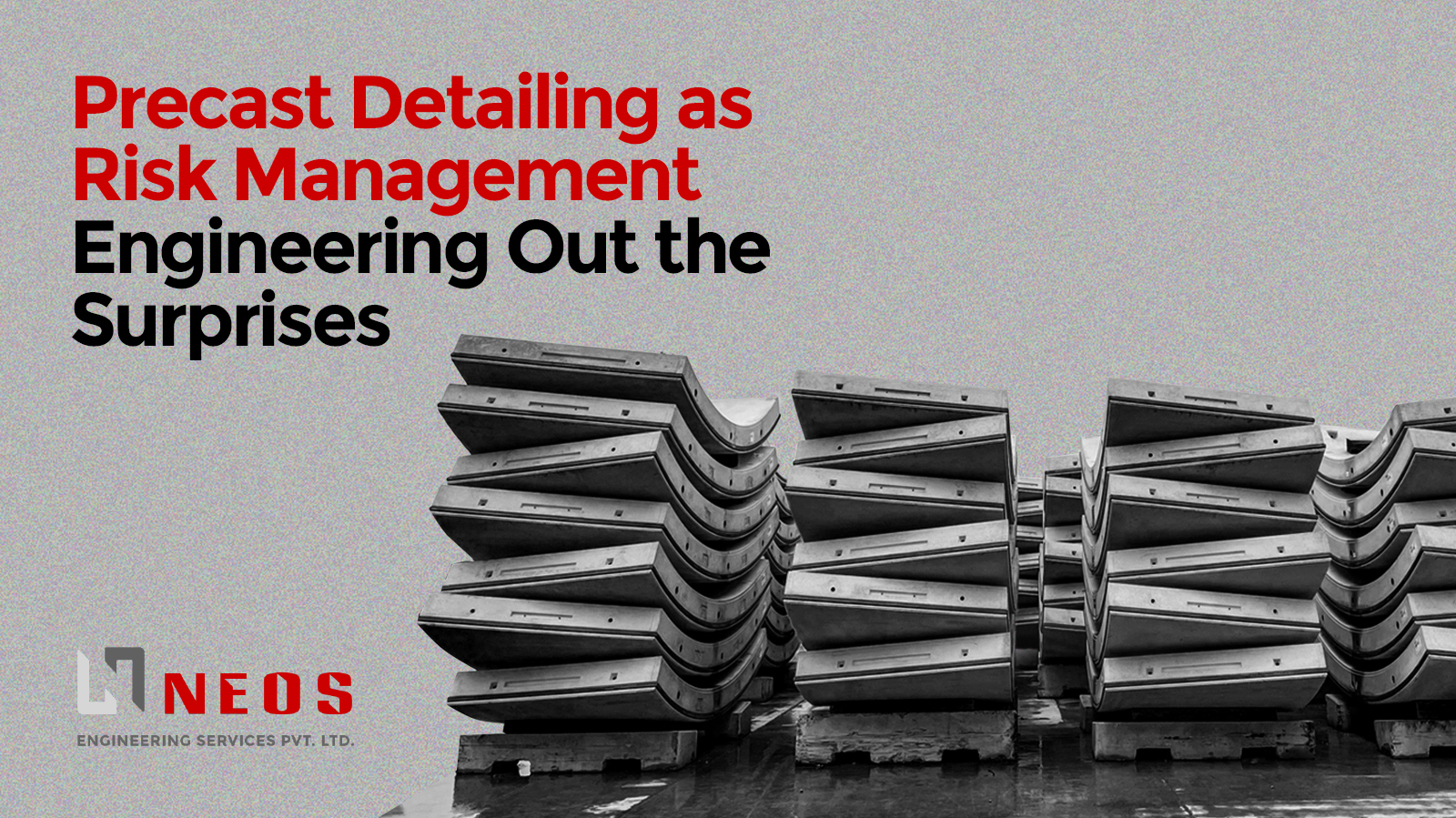
When we think about why construction projects stumble, the usual suspects that come to mind are poor-quality materials or substandard workmanship. But more often than not, projects don’t fail because of weak concrete or unskilled labor. They falter because of unexpected surprises – a rebar clash no one spotted, a panel that won’t fit into place, or a unit too large to load onto a truck.
In precast construction, these surprises aren’t just frustrating – they’re expensive. Idle cranes rack up costs by the hour. Recasting panels causes massive delays. And every error chips away at client trust and project reputation.
Here’s the good news: most of these risks don’t have to happen. The solution lies in treating detailing as a form of risk management – not merely drawing lines on a page, but carefully engineering out the problems that lead to delays, budget overruns, and costly disputes.
The Nature of Risk in Precast Projects
Every precast project carries a unique set of risks, which can be grouped into four main categories:
- Design Risks: Missing tolerances in drawings or rebar that isn’t coordinated with embeds can lead to problems down the line.
- Logistics Risks: Units designed too wide or too tall can’t be transported on standard trailers or through local clearances.
- Site Risks: Panels that don’t fit during erection or ducts that clash with reinforcement cause major headaches during installation.
- Financial Risks: Rework, claims, and penalties are the inevitable result of surprises that stall progress, often eating into budgets.
These risks may seem unrelated at first glance, but they often stem from the same root cause – detailing decisions made too casually or too late in the process.
Detailing as Risk Control
Strong detailing isn’t just about technical accuracy. It’s about thoughtful anticipation. At NEOS, we approach every drawing, every model, and every detail as a tool to manage risk.
Our process focuses on three key principles:
- Identifying Risks Early: We catch clashes, tolerance gaps, or impractical connections long before they appear on site.
- Mitigating Risks Proactively: Every design is checked for transport feasibility, lifting procedures, and erection methods from the very beginning.
- Eliminating Risks Completely: No conflict is left unresolved in the model, because on-site surprises are expensive surprises.
The result? Projects that move forward smoothly, without the unexpected stalls that cause frustration and costs.
Common Surprises and How to Engineer Them Out
Let’s take a closer look at some typical precast surprises, and how NEOS engineers them out of the equation.
1. Transport Surprises
The risk: Units designed too wide for trailers or too tall to pass under bridges.
The impact: Deliveries halt. Cranes stand idle. Panels must be recast — wasting time and money.
Our solution: At NEOS, transport dimensions are an integral part of the detailing model. If a unit doesn’t fit on the truck or pass clearance limits, it doesn’t get detailed that way. This ensures the design is not only buildable but also transportable.
2. Connection Surprises
The risk: Misaligned embeds or joints that don’t match up during panel erection.
The impact: Unsafe assemblies, expensive on-site adjustments, or schedule delays.
Our solution: Every connection is detailed with precise tolerance allowances. Constructability checks confirm that panels fit perfectly in the real world – not just on paper.
3. Clash Surprises
The risk: Ducts cutting through reinforcement or rebar blocking openings.
The impact: Site stoppages, redrawing, and delayed approvals.
Our solution: We perform multi-discipline clash checks early in the process. Conflicts between structural, mechanical, and architectural elements are resolved in the model itself, so nothing unexpected shows up on site.
4. Tolerance Surprises
The risk: Panels designed to “perfect” dimensions that don’t accommodate site variability.
The impact: Grinding, cutting, or even rejecting entire panels.
Our solution: Real-world erection tolerances are built into our detailing from day one. We don’t aim for theoretical perfection; we design for practical constructability.
Case Insight: When Risk Wasn’t Managed
Here’s a story that underlines the importance of a risk-managed approach.
On a past project (not ours), precast units were designed to exact specifications, but nobody checked their transport feasibility. On paper, everything looked flawless. However, when it came time to load the panels onto trailers, they were too wide. Deliveries came to a halt. Cranes stood idle. Panels had to be recast from scratch – a massive expense that could have been avoided with simple foresight.
At NEOS, we don’t allow such oversights. Our philosophy is simple: No unit leaves the model until we know it can leave the yard.
The NEOS Approach: Engineering Out Surprises
For us, detailing goes far beyond drawing lines. It’s a mindset – one that puts risk management at the core.
- Holistic Thinking: Design, logistics, site, and financial risks are never treated in isolation. We address them together, from the start.
- Smart Tools, Smarter Engineers: Software helps us work efficiently and consistently, but it’s our engineers who ensure every detail works in the real world.
- Peer Review and QC: Every model passes through multiple layers of review to catch hidden risks before they become costly problems.
- Client-First Mindset: Our detailing process reduces disputes, keeps schedules on track, and protects the project’s return on investment.
Conclusion: Detail Smarter, Build Safer
Most precast failures don’t happen because of big disasters. They happen because of small surprises that spiral into major problems.
Detailing with risk management in mind means engineering certainty into every decision – designing not just structures, but confidence.
At NEOS, we don’t just deliver drawings. We deliver peace of mind. Every risk we engineer out of the model is one less headache on your site.
Follow our #MistakesThatCostMillions series to see how we turn smart detailing into your strongest form of project insurance.
